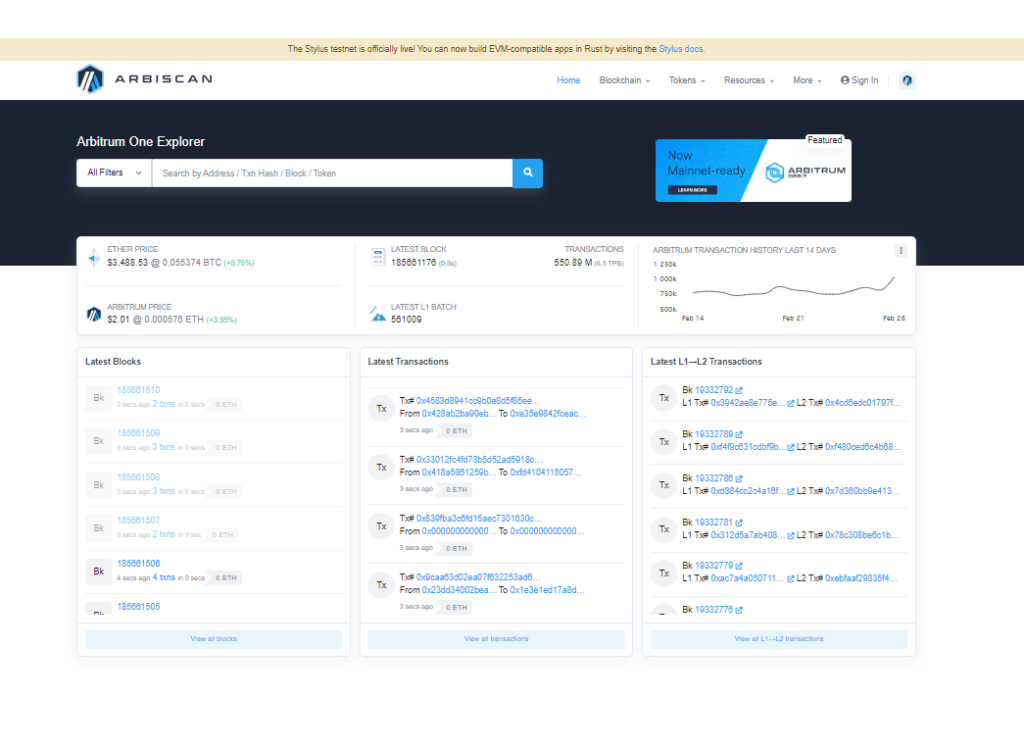- 1 It is a leading blockchain explorer, search engine, API, and analytics platform for the Arbitrum blockchain.
- 2 It contains details of the latest blocks, transactions, current ETH price, current Arbitrum price, and other basic statistics.
- 3 The search bar allows users to search for individual addresses, tokens, smart contracts, transactions, or blocks.
Arbiscan is an Arbitrum blockchain explorer that allows users to track their money and transactions with Arbitrum. It is a layer 2 scaling solution for Ethereum designed to increase efficiency by increasing the speed of transactions while simultaneously reducing costs.
The developers of Arbitrum can use information about transactions on the Arbitrum blockchain, addresses, tokens, prices, and other activities that are being executed on Arbitrum for dApps.
Arbiscan is the leading block explorer for the Arbitrum network and is exclusively designed for the Arbitrum network.
It operates as a comprehensive map, charting all the elements of the Arbitrum network.
It follows a modus operandi comparable to internet search engines used for the blockchain. Users can make use of Arbiscan to examine and inspect detailed information on the network’s transactions, smart contracts, addresses, and blocks.
Its applications make it the most commonly used tool for developers and traders. It can track transaction histories, verify contract deployments, or simply explore the network’s activity in real time.
As one of its more advanced options, it offers analytics on network health, gas fees, and the overall performance of the Arbitrum Layer 2 solution.
Working of Arbiscan
Arbiscan operates by indexing and organizing the data from the blockchain. It enters the Arbitrum network and offers continuous syncing with it to get new transactions, blocks, and smart contracts as they are confirmed and added. Its process involves several key mechanisms:

Node Interaction
Arbitrum nodes are connected to Arbiscan using JSON-RPC, a stateless, lightweight remote procedure call (RPC) protocol. It uses these connections to collect the latest blockchain data, including transactions, smart contract states, and block information.
Data Indexing
Arbiscan indexes information to make it searchable after fetching the data from Arbitrum nodes. It involves organizing data that can be quickly retrieved based on various search queries, such as transaction hashes, addresses, or block numbers.
Moreover, it deploys a series of sophisticated database management systems to efficiently process the large amount of incoming data.
Smart contract decoding
Arbiscan’s contract’s Application Binary Interface (ABI) helps in decoding the data to make smart contract interactions understandable. It allows users to see the details of smart contract transactions in human-readable languages rather than in hexadecimal strings.

Real-time monitoring and analytics
It employs real-time monitoring tools to track network activity, gas prices, and contract interactions. Improve the analytics, which involves complex algorithms and data analysis techniques to provide insights into network health, transaction trends, and other relevant metrics.
User-friendly Interface
The front end presents the indexed blockchain data through a relatively intuitive browser interface. Users can search for specific items, view detailed analytics, and explore blockchain activities without direct interaction with the Arbitrum network.
Key features of Arbiscan
- Users can search for and view the details of all the transactions. It includes all the information related to the sender, receiver, amount transferred, gas used, and transaction status.
- It enables viewing block details such as block height, timestamp, transactions stored within the block, and the miner who validated the block.
- Smart contracts provide insights into smart contracts deployed on the Arbitrum network.
- Address Watchlist is a little tool that allows users to monitor specific addresses and track their balances, transactions, and associated smart contracts.
- Network statistics display real-time historical data on network activity, including transaction volume, gas fees, and network congestion.
- Token Tracker offers information on various tokens within the ecosystem. It includes ERC 20 and ERC 721 tokens, their distribution, and transaction history.
- The decoded data can be presented for easier interpretation of smart contract interactions.
- It provides historical and current data for gas prices. This feature can be used to optimize transaction costs.
- Event logs can help in searching and filtering through event logs emitted by smart contracts, which is important in understanding contract activity and state changes.
- Verified contracts show smart contracts verified on Arbiscan, making their source code available for review and transaction details more transparent.
Conclusion: Functions of Arbiscan
Arbiscan can be used for various functions, such as reading and analyzing transactions and blocks, verifying smart contracts, signing raw transactions, extracting data via APIs, and viewing tokens and statistics.
FAQs
What are the uses of Arbitrum?
It addresses two issues with the Ethereum network: firstly, it acts as a scaling solution, and secondly, it provides a platform for building dApps.
What is the block time for Arbitrum?
Unlike other blockchain networks, it does not have a fixed block time.

Andrew is a blockchain developer who developed his interest in cryptocurrencies while pursuing his post-graduation major in blockchain development. He is a keen observer of details and shares his passion for writing, along with coding. His backend knowledge about blockchain helps him give a unique perspective to his writing skills, and a reliable craft at explaining the concepts such as blockchain programming, languages and token minting. He also frequently shares technical details and performance indicators of ICOs and IDOs.


 Home
Home News
News







